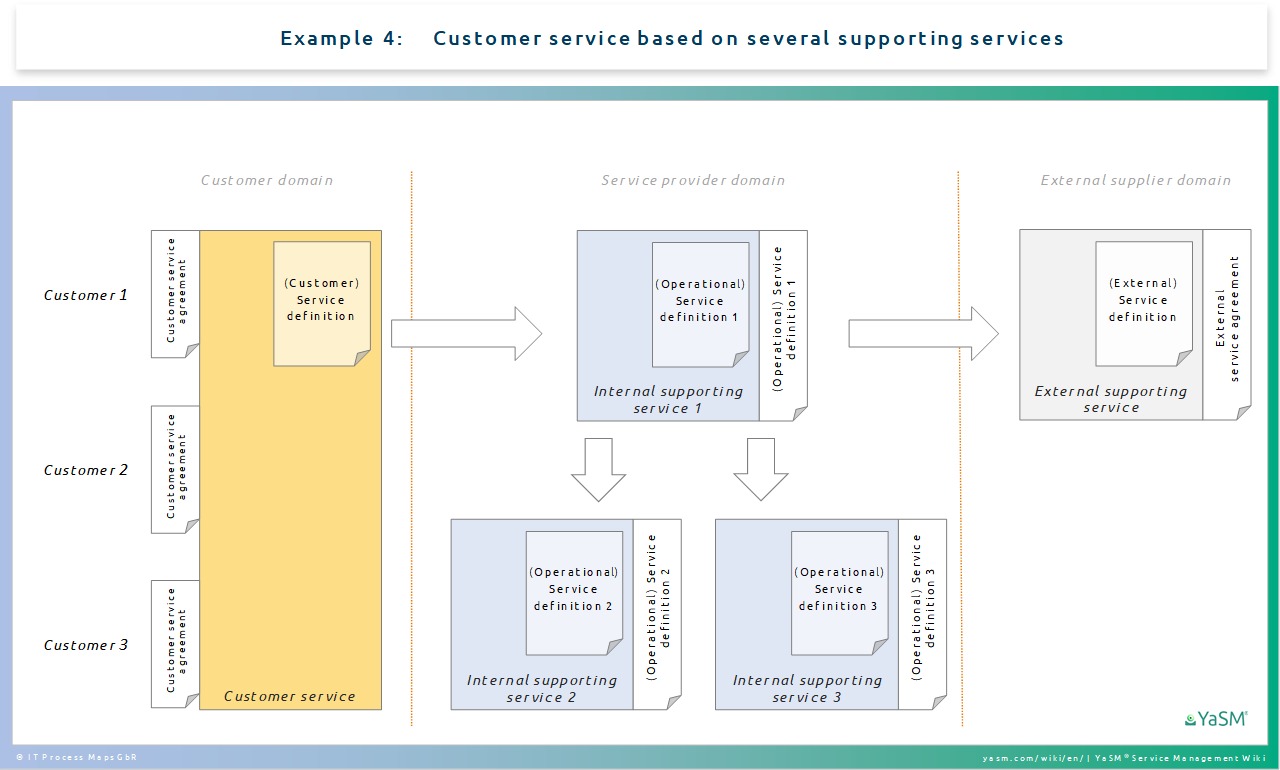Customer vs. Operational Service Definitions and Agreements
One of the important principles in YaSM service management is that customer-facing services are backed up by (internally or externally provided) supporting services. The properties of each service are defined in a service definition, and for each type of service there is a particular type of service agreement.
Part of: Service management concepts
Previous concept: Service portfolio, service definitions and service catalogs
Next concept: Plans for organizing service management initiatives
Types of service agreements
- Customer service agreements
- Customer service agreements represent a commitment by a customer to use a service and the service provider to provide the service, as specified in the service definition.
- Operational service agreements
- Operational service agreements are made between a service provider and a part of the same organization for supplying a supporting service, as specified in a service definition. They represent a commitment by an internal service owner to provide a service within the defined service quality levels.
- External service agreements
- External service agreements are made between a service provider and an external service supplier for supplying a supporting service, as specified in the service definition. They represent a commitment by an external service supplier to provide a service within the defined service quality levels and a commitment by the service provider to purchase specified volumes of the supporting service.
Structure of the service definitions and agreements
Depending on the type of service provider, the structure of the service definitions and agreements will be relatively simple or more complex. The following examples are meant to highlight several possible approaches, taking into account aspects such as the number of customers using a service or the ways in which supporting services are organized:
- Example 1: Individual service for a single customer
- Example 2: Free service provided to multiple customers
- Example 3: Standardized service provided to several customers
- Example 4: Customer service based on several supporting services.
Individual service for a single customer
Example 1:
- A customer service is specifically designed for one customer and only used by that customer.
- No supporting services are required to deliver the service (or the service provider has not defined any supporting services).
In this simple scenario, it will be sufficient to describe the service properties in one service definition document (see fig. 1: "Individual service for a single customer"). A customer service agreement should be signed by the customer, and an operational service agreement should be signed by the service owner (the individual within the service provider organization who is responsible for operating and managing the service).
Free service provided to multiple customers
Example 2:
- A service is provided for free to several customers who are not required to sign up (an example would be a news web site where visitors are not required to register).
- No supporting services are required to deliver the service (or the service provider has not defined any supporting services).
In this scenario, the service properties may be described in one a service definition document (see fig. 2: "Free service provided to multiple customers"). An operational service agreement should be signed by the responsible service owner within the service provider organization.
Standardized service provided to several customers
Example 3:
- A standardized service is provided to several customers who are required to sign up (typical examples are cloud-based applications like Service Now™ or Salesforce®).
- The service provider has defined one supporting service.
In this scenario, the service properties from the customer perspective should be described in a service definition for the customer, and every customer will sign a customer service agreement (see fig. 3: "Standardized service provided to several customers").
The properties of the supporting service should be defined in a definition for the supporting service. An operational service agreement will be signed by the responsible service owner.
Note:
A separate service definition for the supporting service is likely to be needed in this scenario because typically it will differ in some key aspects from the customer service definition. For example, every customer might be guaranteed a certain amount of storage capacity. In this case, the supporting service must guarantee the committed storage space for all customers across the board, even as new customers sign up. The supporting service definition should thus contain scalability provisions - which are not relevant for the customer service definition.
Customer service based on several supporting services
Example 4:
- A service is provided to several customers.
- The service provider uses a number of internal and external supporting services to deliver the service (in the situation illustrated above, supporting service 1 relies on internal supporting services 2 and 3 and on an external supporting service).
In this scenario, the service properties from a customer perspective should be described in a service definition for the customer service, and every customer will sign a customer service agreement (see fig. 4: "Customer service based on several supporting services").
The properties of the supporting services should be defined in service definitions for the supporting services. Operational service agreements will be signed by the responsible service owners within the service provider organization, while external service agreements will be signed by the external service supplier.
Checklist
Notes
By: Andrea Kempter ![]() and Stefan Kempter
and Stefan Kempter ![]() , IT Process Maps.
, IT Process Maps.
Types of service agreements › Structure of the service definitions and agreements › Individual service › Standardized service › Customer service based on several supporting services








